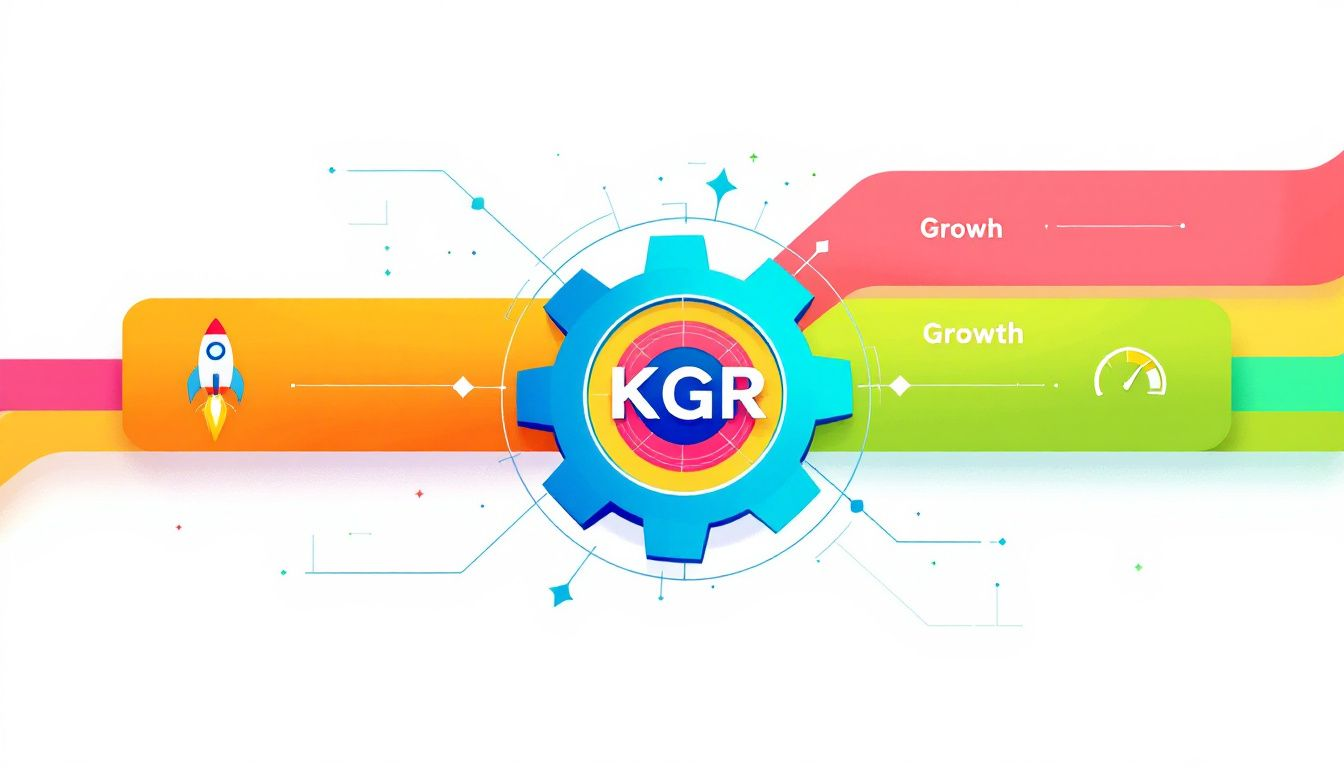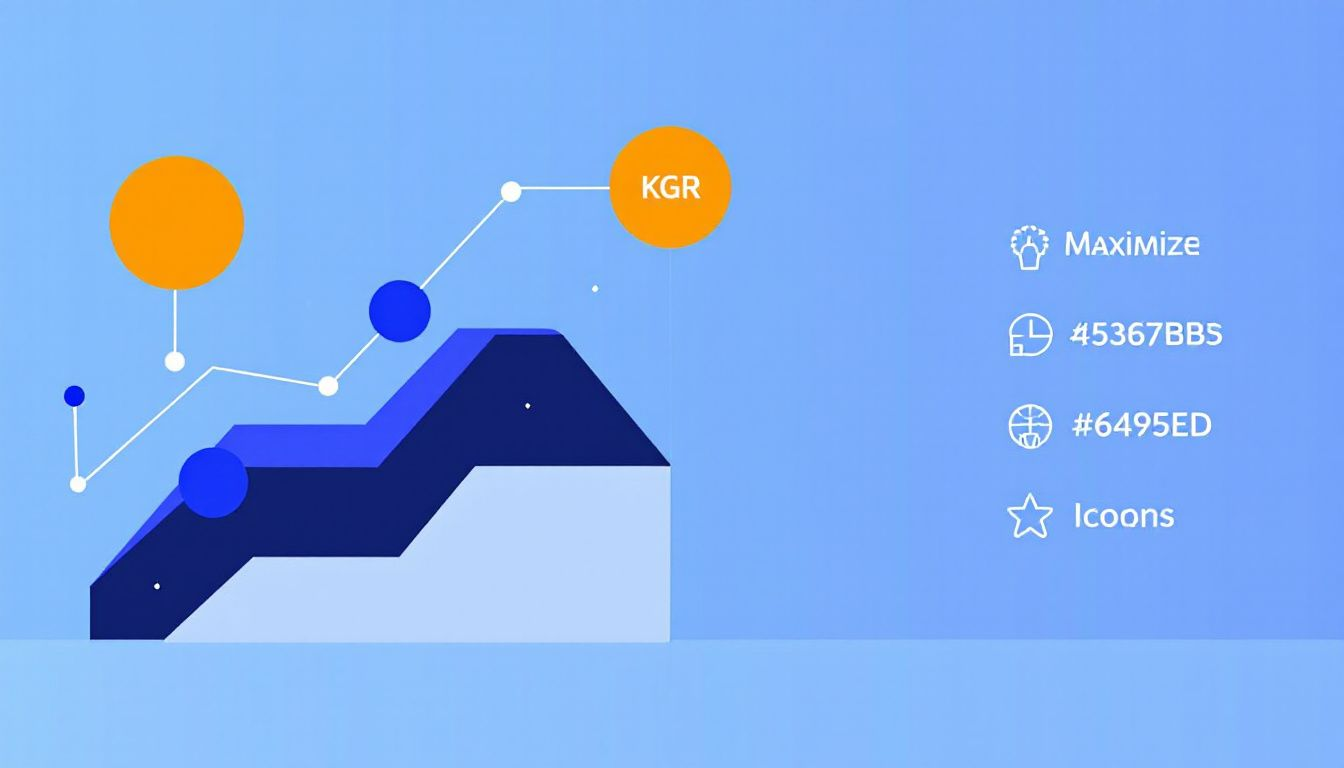The Keyword Golden Ratio (KGR) helps you find low-competition, high-potential keywords to boost search rankings quickly. So what is KGR, and why does it matter? Learn how KGR works and how to use it to improve your SEO.
Key Takeaways
- The Keyword Golden Ratio (KGR) method helps find low-competition, long-tail keywords, allowing for quicker rankings and enhanced website authority.
- Calculating the KGR involves dividing ‘allintitle’ results by search volume; keywords with a KGR below 0.25 indicate optimal ranking potential.
- Consistent publishing of KGR-optimized content, understanding keyword intent, and building quality backlinks are key strategies to maximize the effectiveness of the KGR approach.
Understanding the Keyword Golden Ratio (KGR)

The Keyword Golden Ratio (KGR) isn’t simply a trendy term in the SEO world. It’s an effective strategy for discovering keywords that are less competitive and likely to yield quicker rankings. The KGR approach is particularly adept at identifying highly specific long tail keywords that many competitors may not have targeted. By concentrating on these long tail keywords with low search volumes, one can achieve faster visibility in search engine results with much lower competition levels.
A principal benefit of employing the KGR method lies in its reliance on meticulous manual research over automated tools, which might overlook fine distinctions. This hands-on process is critical for pinpointing kgr keywords that face little competition, thereby providing a distinctive advantage within your SEO tactics. Diligently focusing on well-researched keyword selections can solidify your standing as an authoritative source within your market segment and place you steps ahead of other players.
Leveraging the KGR method as part of your overall SEO plan has great potential to boost site performance substantially. It does more than assist you in outperforming rivals—it also expedites achieving those higher ranks. For emerging websites aiming to establish themselves quickly among search engine results pages (SERPs), adopting this technique can be particularly advantageous, propelling them towards greater online prominence with faster outcomes.
How to Calculate the KGR
Calculating the Keyword Golden Ratio (KGR) is a straightforward process, but it requires precision and attention to detail. The kgr formula for KGR is simple: KGR = (allintitle results) / (search volume). This means you need to know the number of ‘allintitle’ results for a keyword and its monthly search volume to compute the KGR value.
For example, if you have a keyword with 63 allintitle results and a search volume of 250, the KGR score would be 0.25, indicating optimal ranking potential. On the other hand, if a keyword has 4 allintitle results and a search volume of 30, the KGR score would be 0.13. Lower KGR values indicate less competition, making it easier to rank well for those keywords.
To effectively use the KGR method, aim for a KGR value below 0.25 and ensure the search volume is less than 250. Utilizing the ‘allintitle’ search operator helps identify how many pages are optimized for a specific keyword in search results, providing crucial data for calculating the KGR.
Consistently applying this formula allows you to prioritize keywords with the best potential for rapid ranking success.
Benefits of Using the KGR Method

The Keyword Golden Ratio (KGR) approach yields numerous perks that can transform your SEO game plan. It offers the enticing prospect of expedient victories in what is typically a gradual process to build up organic traffic. By zeroing in on keywords that face less competition, the keyword golden ratio strategy greatly accelerates how quickly you climb rankings, enabling swifter realization of outcomes.
A Significant upside is pinpointing those lesser contested keywords that are nevertheless capable of funneling considerable amounts of organic traffic towards your website. This aspect proves particularly beneficial for novices daunted by the plethora of SEO responsibilities. The KGR technique simplifies their efforts by steering them toward crafting superior content without being ensnared by highly sought-after competitive keywords. Steadily releasing material optimized with KGR not only bolsters visibility on search engines, but also cements niche authority.
Employing the KGR method could grant a tactical edge as it primes you to target keywords potentially disregarded by rivals. Securing top-notch backlinks becomes critical for elevating your designated pages’ credibility targeting through KGR use. Such links markedly increase ranking capabilities for these chosen phrases and contribute to faster ascents within rankings.
Finding KGR Keywords
Embarking on the journey to discover KGR keywords might initially seem complex, yet with methodical tactics and appropriate instruments, it not only becomes feasible but can also be quite satisfying. The secret lies in harnessing creativity and being diligent when experimenting with various keywords while addressing keyword difficulties. A myriad of KGR possibilities exists even within highly competitive sectors, presenting opportunities for a variety of keyword approaches.
Committing to test an array of about 20 different KGR terms is more likely to reveal effective keywords that resonate well with your content objectives. Using the framework provided by the KGR methodology helps prioritize those keywords less tapped into, thus sharpening your content strategy and boosting prospects for higher search rankings.
Target a Keyword Golden Ratio (KGR) below 0.25 if you are aiming at significantly increasing your likelihood of climbing up the search results ladder. Incorporating long-tail keywords could haveten a new site’s graduation from Google’s Sandbox phase—paving the way for faster acquisition of web traffic.
Using Keyword Research Tools
Tools designed for keyword research are essential when seeking out keywords that adhere to KGR criteria. Resources such as KWFinder and the Keyword Suggestion function from Keyword.com play a critical role in crafting combinations of keywords, greatly minimizing the groundwork involved in KGR investigation. These platforms offer vital statistics including search volume and keyword difficulty – key indicators for pinpointing prospective KGR keywords.
Commencing the compilation of a list with potential keyword phrases becomes more efficient by utilizing tools like Allintitle KW Explorer, which aids in uncovering regionalized keyword information through adjustments to language and location parameters within your chosen tools. Making use of these utilities simplifies the task of gathering pertinent keyword suggestions while ensuring your approach towards implementing a successful KGR strategy is accurate.
Filtering Keywords by Search Volume
The KGR method places significant emphasis on the selection of keywords based on search volume, honing in specifically on those with a low search volume. It is essential to target keywords that have less than 250 searches per month to meet KGR standards and extract genuine value from them. Resources such as UberSuggest prove useful by offering insights into monthly search volumes along with an understanding of keyword competitiveness.
Leveraging these tools simplifies pinpointing keywords suitable for the KGR approach through precise data about their search volumes and insight into how competitive they are. By establishing a particular threshold for the desired search volume, you can concentrate your efforts on keywords more apt to provide chances for ranking success while steering clear of terms that are saturated with competition.
Analyzing Allintitle Results
The allintitle operator is a powerful tool for identifying the exact match count for keywords in titles. The command ‘allintitle’ helps SEO practitioners determine the level of competition for specific keywords by showing how many pages have optimized title tags for those keywords. Interpreting these results is essential for calculating the KGR and aligning your keyword strategies effectively.
Analyzing allintitle results provides valuable insights into the competitiveness of your chosen keywords, helping you make informed decisions for optimal ranking potential.
Real-Life Success Stories with KGR

The effectiveness of the KGR method is evident in its compelling success stories. One remarkable account involves a website’s revenue soaring from $100 to an astounding $14,853 within twelve months following the adoption of the KGR strategy. Evan S. Porter also experienced notable financial gains with his niche site project, securing a total income of $3,802 by the end of his first year employing this approach.
Doug Cunnington stands as another testament to the power of KGR. He witnessed his site traffic dramatically rise from 4,000 visitors to roughly 35,000 and achieved impressive earnings reaching up to $20,000 per month after committing himself for one full year to integrating KGR into his strategy.
Illustrating how effectively this method can be executed even on newer sites that haven’t yet cemented their rank in search results, these instances highlight how utilizing strategic insights like those provided by implementing KGR can unlock hidden opportunities and provide an edge over competitors not leveraging such techniques for their niche site projects.
Common Challenges with the KGR Method
Employing the KGR method encompasses various advantages, yet it’s accompanied by specific obstacles that one must recognize to apply it effectively. A significant hurdle is the extensive preparatory work and investigation needed for its successful execution. If a keyword selected through this method does not align closely with what users are looking for, there could be a reduction in its efficacy.
Google restricts how many allintitle searches can be performed within certain timeframes – an impediment directly impacting those utilizing the KGR strategy. Adherence to rigid criteria established by KGR might result in fewer available keywords choices. Henceforth necessitating an initial compilation of potential keywords.
Ultimately, persistent effort towards researching and producing content of exceptional quality is imperative when incorporating the KGR technique successfully into your SEO practices. For websites already possessing some level of authority in their domain space may benefit from treating the guidelines provided by KGR more as recommendations than inflexible rules to achieve superior outcomes.
Avoiding Keyword Stuffing
When incorporating KGR keywords into content, it’s critical to avoid the trap of keyword stuffing. Overloading your text with lengthy keyword phrases can render it awkward and unnatural, resulting in a suboptimal user experience. To prevent search engines from imposing penalties for keyword stuffing, ensure that the integration of these terms is seamless and maintains the readability and appeal of your content.
By prioritizing high-quality content that seamlessly includes KGR keywords, you not only enrich the user experience, but also bolster your likelihood of achieving favorable rankings on search engines.
Handling Non-Ranking Keywords
Merely publishing a single KGR article might not secure its position in rankings, since search volume reflects the level of interest—a critical factor when determining KGR. It is crucial to comprehend the search intent associated with KGR phrases to evaluate their ability to rank. Should a KGR post fail to ascend the ranks, it nonetheless has potential for accelerating site traffic despite not expediting an exit from Google Sandbox.
In situations where keywords following the Keyword Golden Ratio (KGR) framework aren’t climbing up in ranking, it’s advisable to release several posts centered around different KGR terms as this may bolster your likelihood of moving up in rankings and subsequently attracting more traffic.
Managing Inconsistent Search Volumes
Various keyword research tools may provide divergent search volumes for identical keywords, which can be perplexing. To tackle this variability, it’s advisable to select a single keyword research tool and utilize it uniformly. Prioritizing the comparative volume between keywords rather than fixating on their precise search volume is crucial as this strategy aids in pinpointing those with more promising ranking prospects.
Adhering to one consistent keyword research tool and concentrating on relative search volumes enables you to make wiser choices regarding the selection of target keywords.
Tips for Maximizing KGR Effectiveness

Employing the KGR method strategically can heighten its efficiency. By regularly publishing content, your site may gain Google’s trust as a credible resource, which can enhance SEO outcomes. Utilizing KGR to pinpoint niche long-tail keywords enables you to attract distinct segments of customers and increase conversion rates.
Leveraging the Keyword Golden Ratio (KGR) method allows for the discovery of keywords where demand exceeds supply, presenting opportunities for faster rankings in search results. In conjunction with using KGR, incorporating additional SEO tactics like acquiring backlinks through guest blogging can amplify your success.
Publishing Consistent Content
Maintaining a steady flow of articles optimized with the Keyword Golden Ratio (KGR) is essential for enhancing your website’s presence and credibility on search engines. A consistent publication timeline aids Google in more efficiently indexing your material, which can lead to improved search engine rankings. By continuously producing content, you cultivate a dedicated readership that frequently visits your site, indicating its value to Google.
To sustain this rhythm of publication and augment the authority of your site progressively, devising a content calendar is advisable. This should detail forthcoming KGR article topics along with their respective deadlines, ensuring adherence to an established publishing cadence.
Tailoring Content to Keyword Intent
Grasping the underlying purpose of KGR keywords is essential for developing content that meets user requirements. When you ensure your content corresponds with what users are searching for, it markedly increases both their satisfaction and their interaction with your material. Recognizing the kind of content that aligns with the intent of specific keywords can drive up user gratification and elevate search engine rankings.
By customizing your content to match the intent associated with keywords, you’re more likely to fulfill what users anticipate finding. This alignment leads to heightened levels of engagement and a boost in conversion rates as a result.
Building Quality Backlinks
Crafting a robust backlink profile is vital for an effective SEO strategy. Securing high-quality backlinks can elevate your positioning on search engine results pages (SERPs) and bolster the credibility of your website. Despite being recognized as one of the more daunting elements in SEO, particularly within highly competitive sectors, it remains essential to enhancing strategies like the KGR method.
Partaking in guest blogging emerges as a potent tactic for garnering esteemed backlinks and augmenting online exposure. When you synergize the precision-targeted KGR approach with a formidable strategy focused on acquiring quality backlinks, you set up your site to scale new heights in terms of rankings and enjoy continuous growth in organic traffic.
Summary
The Keyword Golden Ratio (KGR) method is a powerful tool for achieving rapid SEO wins by targeting less competitive, ultra long-tail keywords. By understanding how to calculate and apply the KGR, you can uncover valuable keyword opportunities, enhance your site’s visibility, and establish lasting authority in your niche. Real-life success stories demonstrate the transformative potential of the KGR method, while practical tips and strategies can help you overcome common challenges and maximize its effectiveness. Embrace the KGR method today and watch your website soar to new heights in the search engine rankings!
Frequently Asked Questions
What is the Keyword Golden Ratio (KGR)?
The Keyword Golden Ratio (KGR) is a powerful strategy for uncovering low-competition, ultra long-tail keywords that can boost your rankings. By focusing on these targeted keywords, you can significantly enhance your chances of success!
How do you calculate the Keyword Golden Ratio (KGR)?
To calculate the Keyword Golden Ratio (KGR), simply divide the number of ‘allintitle’ results for your keyword by its monthly search volume using the formula KGR = (allintitle results) / (search volume).
This straightforward approach helps you identify low-competition keywords to target effectively!
What are the benefits of using the KGR method?
Using the KGR method can quickly boost your SEO by targeting less competitive keywords, leading to increased organic traffic and faster rankings.
Embrace this strategy for a smarter, more effective approach to your online presence!
How can I find KGR-compliant keywords?
To find KGR-compliant keywords, utilize tools like KWFinder and filter by search volume while analyzing allintitle results for low competition.
This targeted approach can lead you to great opportunities for your content!
What are some common challenges with the KGR method?
The KGR method can be a powerful tool, but it often requires significant time for preparation and research, and you may find limited keyword options due to strict criteria.
Stay persistent and adapt your strategy to overcome these challenges!




